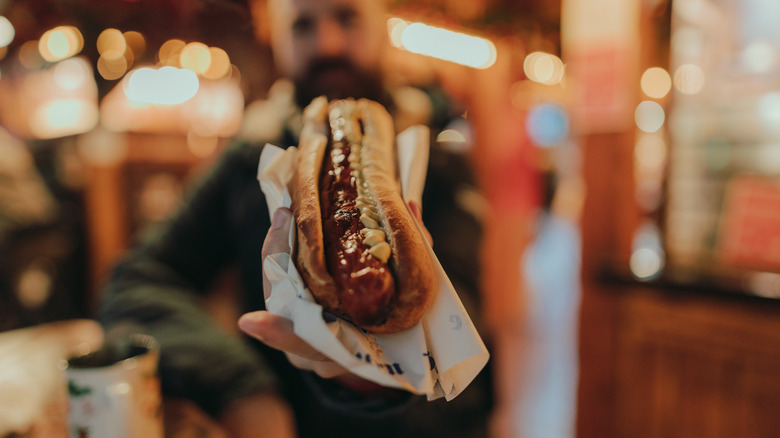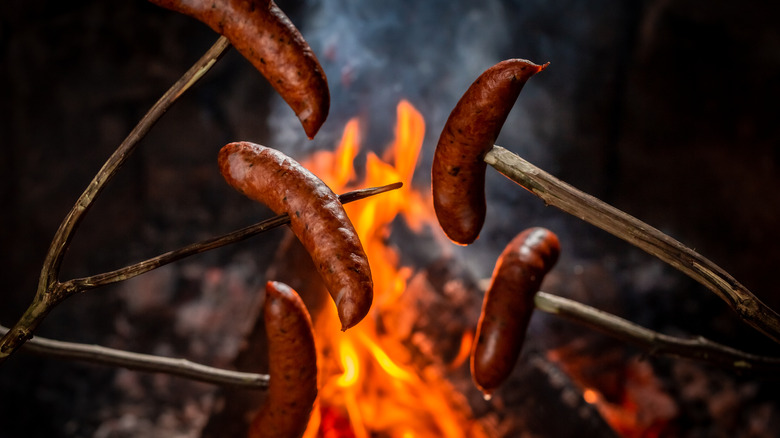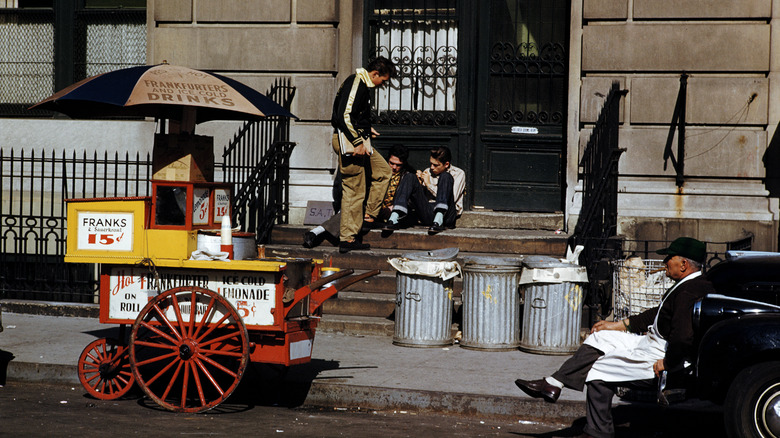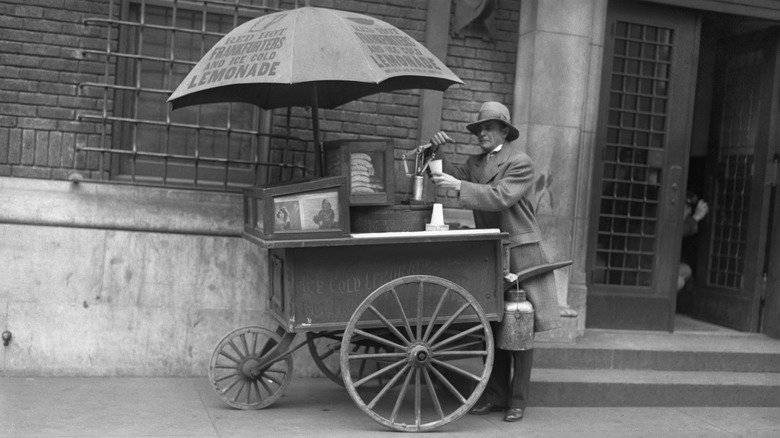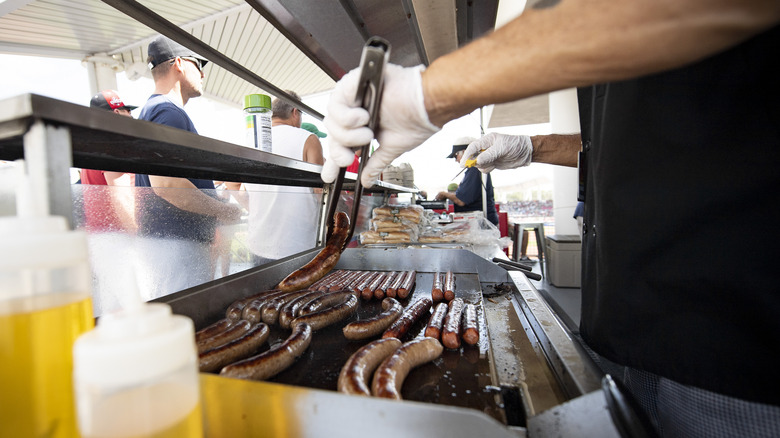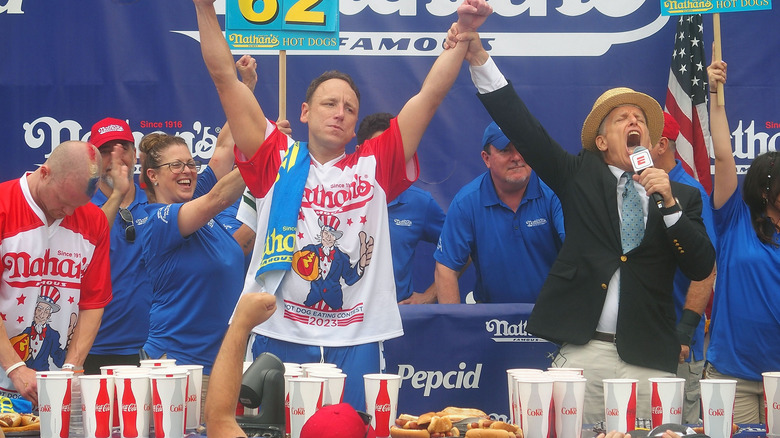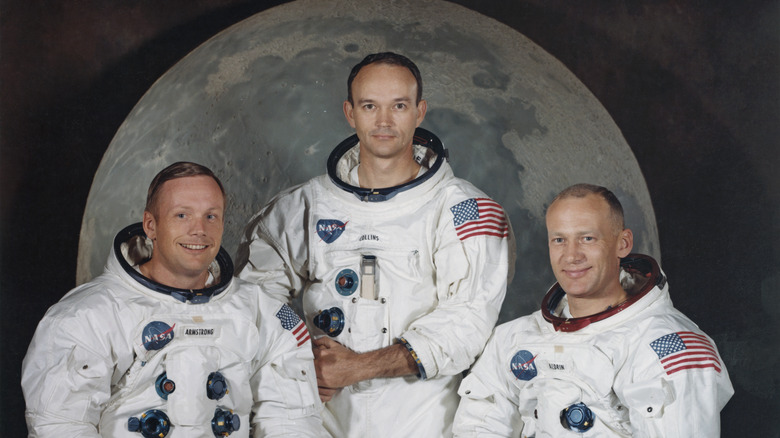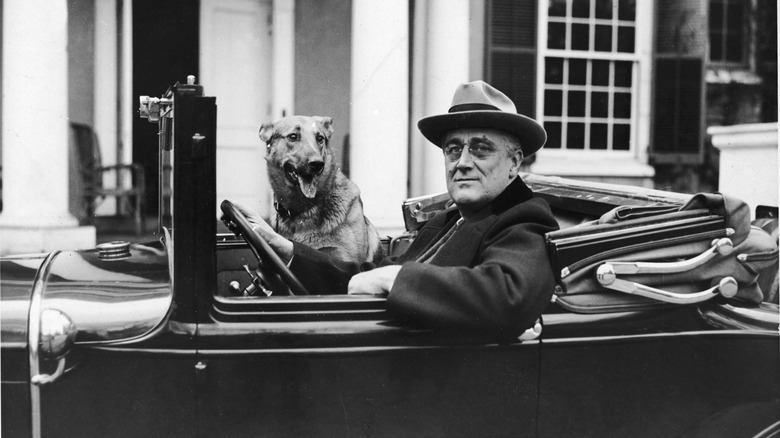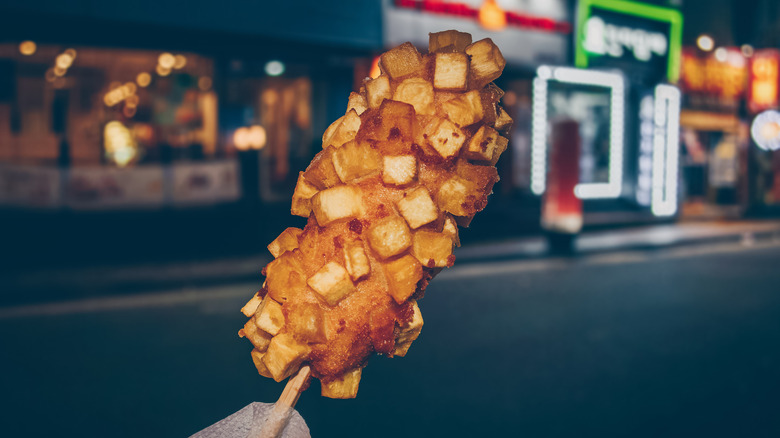The Strange Untold History Of Hot Dogs
Is there any food that represents the American spirit more than the classic hot dog? Ever since the humble sausage in a bun was brought to the United States, it has become a staple in most American diets. According to the National Hot Dog and Sausage Council (yes, it exists), an estimated 20 billion hot dogs are consumed by Americans every single year. That's a whopping 70 hot dogs for every person, every year. Yes, take a minute and try to calculate how many hot dogs you personally gobbled down in the last year.
Hot dogs might have become an incredibly common part of our backyard barbecues, trips to baseball parks, and summer picnics, but have you ever wondered about the history behind hot dogs? This handheld meat delivery system has had a crazy and fascinating pas,t not only in America but throughout the world (and even in space). Get ready to relish in the delicious, untold history of the hot dog.
Sausages have been around since ancient times
When we think of hot dogs, our mind probably first goes to our modern version of them — a juicy sausage in a pillowy bun, laced with ketchup, mustard, and onions on a hot day at the baseball park. But not everyone knows sausages go way back in history to ancient times — and are even one of the oldest forms of processed food. Some of the first records of the sausage can be traced back to 800 B.C. in a line from the Odyssey by Greek poet Homer: "As when a man besides a great fire has filled a sausage with fat and blood and turns it this way and that and is very eager to get it quickly roasted ..." (via What's Cooking America).
It was found in several other places in the world, as well. A type of sausage called the lup cheong was recorded in China around 589 B.C. to 420 B.C. and was made out of goat or lamb combined with salt, green onion, ginger, pepper, and bean sauce.
As always, there are several claims and arguments as to who really invented the first one. But, in the year 64, Roman Emperor Nero Claudius Caesar's cook is often given the credit for discovering the first sausage. The cook, named Gaius, stuffed the intestines of a pig with ground venison and ground beef along with wheat and spices. They were tied into sections, and the sausage was born.
A German peddler first put sausages into buns so people wouldn't burn their hands
Although the creation of the hot dog is still contested to this day, there is one theory many believe to be true. It is widely believed that German immigrants brought the popular sausage to America, but a peddler named Antoine Feuchtwanger is often credited with coming up with the original hot dog. Feuchtwanger was a vendor that sold hot sausages on the streets of St. Louis, Missouri. The problem? Those hot sausages were HOT.
Feuchtwanger came up with the idea to lend white gloves to his customers so they wouldn't burn their hands. However, the idea didn't work for several reasons. One, he began to see his profits decrease because his customers would just take the gloves instead of returning them. Secondly, the gloves were a pain to get on and off. In the end, the sausages weren't really convenient to eat as street food.
Enter: Mrs. Feuchtwanger. Antoine's wife saw the problem and suggested a genius solution that would change the history of American food forever: Why not put the sausages in a split bun instead? Antoine took his wife's advice and asked his brother-in-law to help. He turned long, soft rolls into the first hot dog buns that would snugly fit the sausages. Although the name "hot dog" was still yet to come, Antoine is believed to have created the first hot dog stand.
The name hot dog started back in the 1880s
The name "hot dog" has an interesting story of its own, although it's not totally clear which is true. Before hot dogs were a thing, the name "dachshund" dogs can even be traced back to German roots, which likely began as a joke about small, long, thin dogs. But, what about in America?
One story says the name was created at a New York Giants baseball game at the New York Polo Grounds in 1901. On a chilly day, sausage vendors that were selling their fare from hot water tanks could be heard shouting, "They're red hot! Get your dachshund sausages while they're red hot!" (via the National Hot Dog and Sausage Council). A popular sports cartoonist from the New York Journal named Tad Dorgan heard this and drew a cartoon that featured dachshund sausages lying in warm rolls. He didn't know how to spell the word "dachshund," so he wrote "hot dog!" instead. However, this theory has mostly been disregarded because the original cartoon was never found.
Many other hot dog historians believe "hot dog" began somewhere in the 1880s to 1890s. It became common to call sausages "dogs" in a sarcastic way, commenting on how the meat it contained was a mystery. Back then, it was rumored that dog or even horsemeat was used in the sausages. By 1894, "dog wagons" was a common term at Yale, referencing the vendors selling hot dogs at the dorms.
Baseball stadiums have served hot dogs since the beginning ... but why?
Hot dogs and baseball go together like peanut butter and jelly. According to Webstaurant Store, an estimated 22 million hot dogs are sold every year at major league ballparks. How did the hot dogs become standard fare at baseball stadiums? Again, the answer is clouded in history, but there are several theories.
Some historians believe Chris Von der Ahe, a saloon proprietor and owner of the St. Louis Browns major league baseball team, was the man to thank. Apparently, he purchased the Browns in order to market himself and his saloon business in a bigger way. Legend has it he introduced sausages to go with his already-popular beer at baseball games. However, this was never fully proven.
Another claim suggests an immigrant named Harry M. Stevens introduced hot dogs to baseball in New York. He was originally hired to sell scorecards at games, but he eventually decided to expand his business to selling concessions. One day, when ice cream wasn't selling in the cold weather, he added "red hots" to the menu — sausages stuffed into Vienna rolls. Again, the validity of the story changes depending on who you ask, but in a book called "Dictionary of 1913 Baseball and Other Lingo" by Gerald Cohen, Harry Stevens is quoted saying it was his son's idea to serve hot dogs at the stadium, and that he wanted to serve ham and cheese!
How hot dogs became the iconic food for eating competitions
What's the first food you think of when an "eating competition" comes up? Of course, it's hot dogs. But, why did stuffing hot dogs down one's gullet become a national tradition in America?
According to legend, the sacred competition can trace its history back to Independence Day on Coney Island, specifically at the site of the original Nathan's Famous hot dog stand. Although the story has been disputed by some in recent years, it is said that on July 4, 1916, four European immigrants were arguing about who was the most patriotic of the bunch. The only reasonable way to settle the dispute? A hot dog eating contest. An Irish immigrant named Jim Mullen won the original competition by downing 13 hot dogs. Although the legendary story was later claimed to be made up in order to market the contest, there's no arguing the mark it made on American history.
Every year, Nathan's Famous Hot Dog Eating Contest features the world's top competitive eaters downing as many hot dogs as possible on U.S. Independence Day. Joey Chestnut holds the all-time record with 62 hot dogs in 10 minutes, while Miki Sudo set the women's record with 48.5 hot dogs in 10 minutes, according to Nathan's official website.
Hot dogs ... on the moon?
Not only are hot dogs a beloved food on Earth, but they've made their way into space, as well. The Apollo 11 mission that sent Neil Armstrong, Michael Collins, and "Buzz" Aldrin to the moon also featured hot dogs to fuel the astronauts on their mission. The hot dogs were labeled as "thermostabilized frankfurters" with a "thermostabilized cheddar cheese spread," according to the official NASA report.
Although a NASA public affairs officer named Brandi Dean confirmed hot dogs were in fact sent to space, she warned that they looked a little bit different than the hot dogs we're used to on Earth. "The Apollo 11 crew ate a sort of military version of a hot dog," Dean told USA Today. "Probably not quite what most people think of when you say 'hot dog,' but it's a sausage in a pouch, and could probably be called a hot dog if you squint a little!"
50 years after the Apollo 11 mission in 2019, the National Hot Dog and Sausage Council (NHDSC) celebrated the hot dog as one of the first foods eaten by Neil Armstrong and "Buzz" Aldrin on their courageous mission. Even the most dangerous missions in the galaxy are not complete without delicious hot dogs.
President Franklin Roosevelt offered English royalty hot dogs
If you hosted a king and a queen to a meal, what food would you serve them? Kobe beef with white truffles? Caviar and Iberico ham? That's not what President Franklin Delano Roosevelt and his wife, Eleanor, had in mind when they hosted King George VI and Queen Elizabeth at a picnic in the Hudson Valley. They served good ol', American hot dogs to their royal guests.
Apparently, the royal couple had never tried hot dogs in their life, and the queen even asked, "How do you eat this?" (via HV Mag). Roosevelt answered, "Very simple. Push it into your mouth and keep pushing it until it is all gone" (via Smithsonian Magazine). Although she ignored Roosevelt's advice and opted for a knife and fork, her husband ate it with his hands — they both enjoyed the meal.
The meeting was an incredibly important time in American history, as it was the first time a reigning British monarch had ever set foot on American soil. It was also when Europe was right on the brink of World War II, and the meeting not only helped solidify a relationship between the two countries but led to the U.S. entering the war. Depending on how you look at it, you could say these hot dogs might have helped the West win World War II, even if in a small part.
The (annoying) reason why hot dogs don't match the number of buns in packages
If you've ever gone to the supermarket to prepare for a fun backyard barbecue, only to find yourself annoyed that hot dogs come in packs of 10 while buns come in packs of 8 — you're not alone. Long have Americans run into the gut-wrenching issue of two extra sausage weiners when purchasing said ingredients from the store. It even got to the point when ketchup brand Heinz started a petition for bun and weiner companies to come together and match how many of each item comes in a normal pack of their products.
Why has this seemingly fixable issue persisted for so long? The answer is simpler than you might think. When hot dogs were first being sold in the United States, they weren't actually being sold in grocery stores. Hot dog purveyors had to order the meats in wholesale quantities, and they chose what they thought was the most natural number: 10. However, when bakeries started to produce buns to be sold to the public, they used pans that could only bake those iconic long rolls in groups of four, which meant their packages stacked 8 buns, instead of 10. Seems like a fixable issue, no?
Countries around the world create their take on the classic hot dog
Sure, Americans have countless variations of the hot dog, from the simple New York hot dog topped with spicy mustard and sauerkraut to the Chicago dogs loaded with pickles, hot peppers, sweet onion, relish, and tomato. But, Americans aren't the only ones who find hot dogs to be delicious. Countries all over the world have adopted the tubular snack and have put their own spin on it.
Head over to South Korea and you'll find a deep-fried hot dog that is trending all over the world. It's basically a deep-fried, battered hot dog crusted with french fries, slathered with sauce, and served on a stick like a corn dog. You'll also find other creative crusts that replace the potatoes with ingredients such as instant ramen noodles. In nearby Japan, they love their octopus hot dogs — tiny little weiners that are cut to have four "legs" protruding from the bottom.
In Mexico, you'll find "jochos" or "dogos" — hot dogs served with chopped tomatoes, onions, jalapeños, bacon, mushroom, guacamole, and even french fries. In Venezuela, you'll find dogs topped with carrot and cabbage salad, crispy potato sticks, and grated cheese. If you head over to El Salvador, a "chorys" doesn't feature a boiled or grilled sausage, but one that comes fried and topped with onions, escabeche, and jalapeño. These only scratch the surface, but one thing is clear: The world loves their hot dogs.
A Seattle food truck used to sell the world's most expensive hot dog
Hot dogs are usually considered a humble food that costs a couple of bucks, but that's not what Seattle's Tokyo Dog had in mind. Although the food truck has since closed to customers, it used to be known for one, very important thing: the most expensive hot dog in the world. Biting into one of these franks would have set you back $169.
The "Juuni Ban," as it was dubbed by the food truck, included ingredients you might not even find at your favorite Michelin-starred restaurant. If you decided to pay up, you'd get a hot dog that contained smoked cheese bratwurst, butter teriyaki grilled onions, Maitake mushrooms, Wagyu beef, foie gras, shaved black truffles, Japanese mayonnaise, and of course, caviar — all served on top of a brioche bun. But, how did it taste? According to Jean Nakayama, a chef at a local Seattle restaurant, "All ingredients were genuine and cooked to perfection. Presentation excellent. Total satisfaction!" (via Guinness World Records).
In order to be accepted into the Guinness World Records, the business needed to sell at least one hot dog. After announcing the new menu item, the creators sold six Juuni Bans in a day, raising $1,014, which they donated to the American Red Cross.
